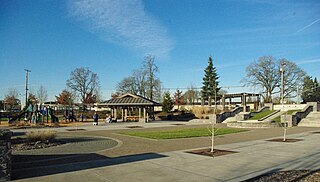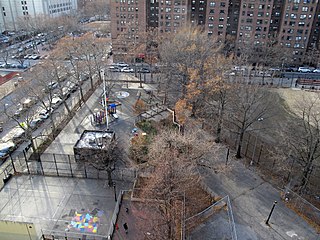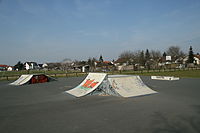
A skatepark, or skate park, is a purpose-built recreational environment made for skateboarding, BMX, scootering, wheelchairs, and aggressive inline skating. A skatepark may contain half-pipes, handrails, funboxes, vert ramps, stairsets, quarter pipes, ledges, spine transfers, pyramids, banked ramps, full pipes, pools, bowls, snake runs, and any number of other objects.

A half-pipe is a structure used in gravity extreme sports such as snowboarding, skateboarding, skiing, freestyle BMX, skating, and scooter riding.

Inline skating is a multi-disciplinary sport and can refer to a number of activities practiced using inline skates. Inline skates typically have two to five polyurethane wheels depending on the style of practice, arranged in a single line by a metal or plastic frame on the underside of a boot. The in-line design allows for greater speed and maneuverability than traditional roller skates. Following this basic design principle, inline skates can be modified to varying degrees to accommodate niche disciplines.

A terrain park or snow park is an outdoor recreation area containing terrain that allows skiers, snowboarders and snowbikers to perform tricks. Terrain parks have their roots in skateparks and many of the features are common to both.

A longboard is a type of skateboard typified by longer decks and wheelbases, larger-diameter and softer (lower-durometer) wheels, and often lower riding height compared to street skateboards, though there is wide variation in the geometry and construction of longboards. Among the earliest types of skateboards, longboards were inspired by surfing, with early longboards drawing from the design of surfboards, resembling and mimicking the motion of riding a surfboard, but adapted to riding on streets in a practice known as sidewalk surfing.

The ollie is a skateboarding trick where the rider and board leap into the air without the use of the rider's hands. It is the combination of stomping, also known as popping, the tail of the skateboard off the ground to get the board mostly vertical, jumping, and sliding the front foot forward to level out the skateboard at the peak of the jump.

Freestyle BMX is bicycle motocross stunt riding on BMX bikes. It is an extreme sport descended from BMX racing that consists of five disciplines: street, park, vert, trails, and flatland. In June 2017, the International Olympic Committee announced that freestyle park was to be added as an Olympic event to the 2020 Summer Olympics.

Mike McGill is an American skateboarder who is best known for inventing the trick entitled the "McTwist", an inverted 540 degree mute grab aerial.

In skateboarding, grinds are tricks that involve the skateboarder sliding along a surface, making contact with the trucks of the skateboard. Grinds can be performed on any object narrow enough to fit between wheels and are performed on curbs, rails, the coping of a skate ramp, funboxes, ledges, and a variety of other surfaces.

A slide is a skateboarding trick where the skateboarder slides sideways either on the deck or the trucks.

The Burnside Skatepark is a DIY concrete skatepark located in Portland, Oregon, United States. Burnside was the first DIY skatepark project. It is located under the east end of the Burnside Bridge. The project was started without permission from the city of Portland before being accepted as a public skatepark. Its features include many hips, pools, pyramids, and vertical sections. The skatepark receives no funding from the city of Portland. The park is regarded as an on-going project that is funded by donations.
A skateboard style refers to the way a skateboarder prefers to ride a skateboard. Skateboard styles can be broadly divided into two different categories: skateboarding to perform tricks and skateboarding as a means of transportation. Styles of skateboarding have evolved and are influenced by a number of factors including sociocultural evolution, mass media, music, technology, corporate influence and individual skill level.

Reedville Creek Park is a municipal park in the Reedville neighborhood of Hillsboro, Oregon, United States. Opened in 2003, the 9.6-acre (39,000 m2) park is along Cornelius Pass Road at Francis Street in the southeast area of the city. The park includes basketball courts, children’s play equipment, a picnic shelter, tennis courts, and sports fields among other amenities. Reedville Creek was the first and is the only park in Hillsboro with a skatepark.

Skateboarding arrived in China in April 1986 when an American skateboarder arrived in China to study Chinese at the Beijing Language Institute. He says, "When I arrived in China, there wasn't even a word in Chinese for skateboard. People were really interested in learning to ride, and in a few years Chinese skaters started appearing in almost every city I travelled to". Domestic skate companies and retailers began to appear at around the turn of the century, bringing the average price for a skateboard of ordinary quality down from an expensive 1000 yuan to around 280 yuan as of 2009. Skateboarding has been slow to develop in China because of the lack of a strong preexisting street culture and of skating infrastructure; nevertheless, it's estimated that as of 2009 there are 40,000 to 50,000 skateboarders in China.
Turf Skatepark, also known as "Surfin' Turf" or "The Turf", is a former skatepark located in Greenfield, Wisconsin, United States, less than one mile south of the city of Milwaukee. The Turf was an indoor/outdoor facility consisting of five sculptured concrete pools providing some of the best terrain of its time.

Street skateboarding is a skateboarding discipline which focuses on flat-ground tricks, grinds, slides and aerials within urban environments, and public spaces. Street skateboarders meet, skate, and hang out in and around urban areas referred to as "spots," which are commonly streets, plazas or industrial areas. To add variety and complexity to street skateboarding, obstacles such as handrails, stairs, walls, flower beds, bins, park benches, picnic tables, and other street furniture may be traversed as single tricks or as part of a series of consecutive tricks called a "line."

Coleman Playground is a public park on the border between the Chinatown and Lower East Side neighborhoods of Manhattan in New York City.

Texas Beach Skate Park, also known as Treasure Island Community Skate Park, is a DIY skatepark located within the planned Riverview Community Park in the Texas Beach riverside area on the north bank of the James River in Richmond, Virginia, United States.

Andy Kessler Skatepark formerly Riverside Skatepark is a skatepark located in Riverside Park on the Upper West Side of Manhattan, New York City. Riverside Skatepark is notable as the first full-sized public skatepark in Manhattan, designed and built by renowned skateboarder and skatepark builder Andy Kessler.





















